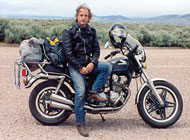A Lot To Be Gleaned From 2018 Colorado Motorcycle Crash Stats
I recently acquired a trove of motorcycle crash information for 2018, put together by the Colorado State Patrol (CSP). This is going to take several blog posts to present.
The report starts with a summation, presenting the overall stats up front. I’m just going to copy/paste that summation here.
- Statewide in 2018, there were approximately 120,000 motor vehicle crashes and 2,206 (1.8 percent) of those crashes involved motorcycles. There were 111 MOST students (from fiscal year 2018) involved in a crash in 2018.
- Of the 2,206 crashes involving a motorcycle, 522 crashes resulted in a serious injury and 97 crashes resulted in a fatal injury.
- The motorcycle operator was at fault in the crash 63.8% of the time (1,408/2,206). Among the 111 motorcycle operators who were MOST students in 2018 and had a crash, 77 were at fault in the crash (69.4%).
- In 2018, there were 141 crashes where alcohol or drugs were suspected among motorcycle operators at fault in a crash. 116 of the motorcycle operators were suspected of alcohol use only, 6 operators were suspected of drug use only, and 19 motorcycle operators were suspected of both alcohol and drug use. Only six MOST students were suspected to be impaired by drugs or alcohol at the time of the crash.
- In 2018, among all motorcycle operators and passengers involved in a crash, 49.5 percent (1,223/2,470) were properly wearing helmets.
You’ll notice that these stats tell us how many and what percentage of these crashes involved riders who had received rider training through the Motorcycle Operator Safety Training (MOST) program. This is the first year this information has been tallied and it came following a request from ABATE of Colorado. ABATE thanks you CSP.
The one thing I’m not clear on–and maybe I can get this answered at the next ABATE D-17 meeting–is that this reads in a way to suggest that we’re only talking about MOST students who took the training in 2018. Is that really the case? Did 111 2018 MOST students crash? Like, in their first year riding after taking the training? I’d like to know how many riders MOST trained during the year. What percentage is this? And then what about the tally if you consider all riders who have ever had MOST training? I have, but not in 2018. I also didn’t crash in 2018.
The one number above that really strikes me is that third bullet. It says that the rider was at fault nearly two-thirds of the time, and a bit more than two-thirds of the MOST-trained riders were at fault.
Wow, what does this say about rider training? Or what does it say about the riders being trained? I have no concrete answer to those questions but I can relate anecdotally some information I have heard. That is, many of the riders being trained are there because they have to be. They were caught riding without being licensed to do so and in order to avoid worse punishment they agreed to take rider training and get accredited to ride a motorcycle. Maybe for them it was just a formality and they then went back to their wild and crazy style of riding that got them stopped in the first place. Makes you wonder.
Or here’s another thought. Those numbers don’t show if the crash happened before or after training. Perhaps a lot of riders crashed, were found not to have accreditation, and took the course afterward to minimize penalties. I’m going to need to talk with Chris Corbo, the MOST coordinator, and ask some questions.
On the more positive side is that fourth bullet that says 141 crashes involved drugs or alcohol but only 6 of those were MOST-trained riders.
There’s a ton more information in this report. Y’all come back now, hear?
Biker Quote for Today
I used to think I’d go out with a bang, on the back of a Harley, racin’ a train. — Joe Nichols
Tags: Colorado motorcycle crashes 2018, motorcycle crash statistics

